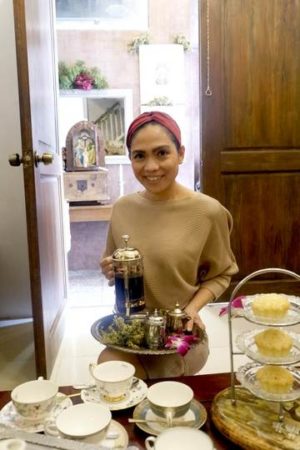
Chocolate Queen Raquel Choa serving the kape-sino or pinaig
OUR country is a land rich in customs and traditions. The deepest and lasting ones are mostly influenced by Spain.
Being the only predominantly Roman Catholic nation in Asia, we are steeped in deeply religious traditions. Our fiestas and in celebration of our patron saints.
Cebu celebrates the Feast of the Sto. Niño every third Sunday of January. The Sinulog or Sto. Niño Festival has become a major event for the city.
The Casa de Cacao is filled with vignettes of our traditions. No less than the Chocolate Queen, Raquel Toquero Choa, plays a gracious host to her home that relives traditions of the past.
The legend of Maria Cacao is alive in her home, which Raquel never gets tired of sharing. Her invitation for a merienda, high tea style, was actually a journey to our immediate past influenced by the lifestyle of our grandparents.
The sepia-motif interiors transport one to an old world.
The Spanish-inspired chandeliers and her collection of antiques reflect our rich past. An icon of the Sto. Niño dominates the entrance into the living room which contains a richly carved wooden and upholstered sala set.
The ornate coffee table was set with dainty teacups and tiered high tea trays filled with tablea cupcakes, torta and Queen’s chocolate loaf.
The aroma of freshly-pressed kape-sino, also called “pinaig” by locals greeted our nostrils. Kape-sino is actually a glamorized term for “kapeng sinunog” made from roasted #16 white corn grits.
Thirteen-year-old Rose
Angelie, the seventh of Raquel’s eight children, has mastered the art of roasting the corn grits.
The roasting requires precision to get the right flavor, which she can do just by looking at the color of the grits—golden dark, brown.
The kape-sino brought me back to our ancestral home in Tondo, Manila where children were allowed to take coffee made from roasted soya beans.
Youngest of Raquel’s children, 11-year-old JP was unobtrusively hovering around, ready to assist in serving.
The French press was too much for him to handle so his mom took over. Kape-sino is best taken “black” without cream or sugar that paired well with the cakes. The torta is light in color and used manteca de cacao or cocoa butter. I just loved the tablea cupcakes, moist and chewy.
The Queen’s chocolate loaf was hand-mixed, with the cake mixture done by bare hands. Raquel was quick to add that they do not use electric mixers.
While enjoying the merienda, chocolate expert Edu Pantino operated the gramophone manually (yes, no electricity!) and played old long-playing waltz records. Raquel and I even took to the floor and waltzed! With the gramophone losing power, we sang Filipino songs like Paru-Parong Bukid and Leron-Leron Sinta.
We moved to the elegant dining table where more tablea creations awaited us. The cacao de bola, a versatile ball of pure chocolate, was ready to be grated over the prepared food, just like one uses grated cheese.
Mole, a sauce made of tablea, finger chilies, siling labuyo or kulikot, bell pepper, onion, garlic, celery, carrot, star anise and annatto seed juice or achuete and sweetened tablea is a new creation of Raquel. We dipped freshly baked bread made with kape-sino into the exotic sauce.
The sausages tasted even better with grated cacao de bola. Pit Senyor!

